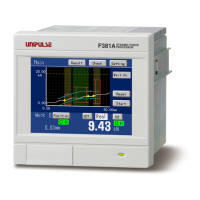12
2 INSTALLATION AND CONNECTION
12
INSTALLATION AND CONNECTION
Chapter
2
- Option (Displacement input: Pulse input (line driver) [LDI])
Type Pin No. Signal Use
Load input
1+EXC
Terminal to supply the voltage of the strain gauge type sensor.
Connect +IN of the strain gauge type sensor.
2-SIG
Terminal to input the signal of the strain gauge type sensor.
Connect –OUT of the strain gauge type sensor.
3-EXC
Terminal to supply the voltage of the strain gauge type sensor.
Connect -IN of the strain gauge type sensor.
4+SIG
Terminal to input the signal of the strain gauge type sensor.
Connect +OUT of the strain gauge type sensor.
5F.G.
Frame ground terminal to connect the shielded wire of the strain gauge
type sensor connecting cable.
Analog
monitor
output
6
VOL
OUT
Terminal to output voltage proportional to the input of the strain gauge
type sensor. (Approx. 2V per 1mV/V)
Connect a pen recorder, etc., for simply monitoring the input of the
strain gauge type sensor.
7GND
Ground terminal of VOL OUT.
Displacement
input
(LDI)
8F.G.
Frame ground terminal to connect the shielded wire of the pulse output
sensor connecting cable.
9A+
Terminal to input the A+ (PCA, φA) output of the pulse output sensor.
Connect the A+ (PCA, φA) output of the pulse output sensor.
10 A-
Terminal to input the A- (A/, A, *PCA, φA) output of the pulse output
sensor.
Connect the A- (A/, A
, *PCA, φA) output of the pulse output sensor.
11 B+
Terminal to input the B+ (PCB, φB) output of the pulse output sensor.
Connect the B+ (PCB, φB) output of the pulse output sensor.
12 B-
Terminal to input the B- (B/, B, *PCB, φB) output of the pulse output
sensor.
Connect the B- (B/, B
, *PCB, φB) output of the pulse output sensor.
Please calibrate it after wiring the sensor.
See the following:
Load: "4-2.Y-axis setting" on p.39
Displacement: "4-3.X-axis setting" on p.42
Attention

